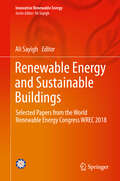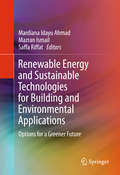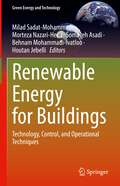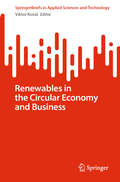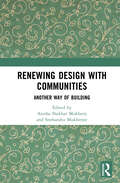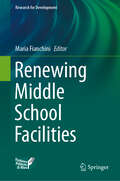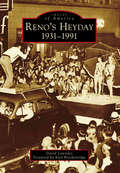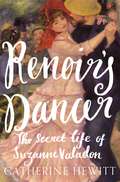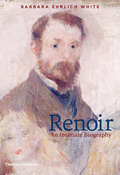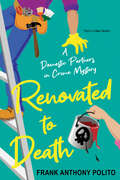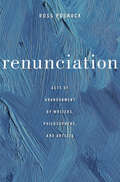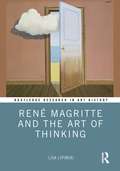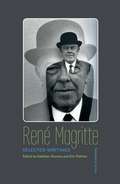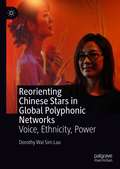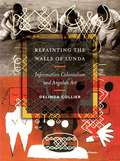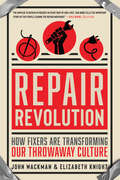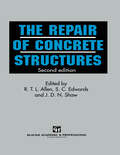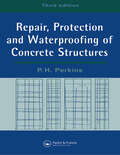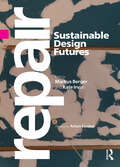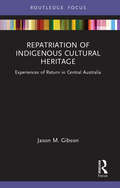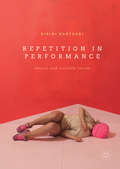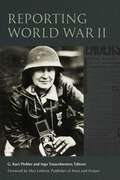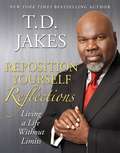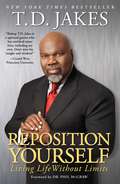- Table View
- List View
Renewable Energy and Sustainable Buildings: Selected Papers from the World Renewable Energy Congress WREC 2018 (Innovative Renewable Energy)
by Ali SayighThis book contains selected papers presented during the World Renewable Energy Network’s 28thanniversary congress at the University of Kingston in London. The forum highlighted the integration of renewables and sustainable buildings as the best means to combat climate change. In-depth chapters written by the world’s leading experts highlight the most current research and technological breakthroughs and discuss policy, renewable energy technologies and applications in all sectors – for heating and cooling, agricultural applications, water, desalination, industrial applications and for the transport sectors.Presents cutting-edge research in green building and renewable energy from all over the world;Covers the most up-to-date research developments, government policies, business models, best practices and innovations;Contains case studies and examples to enhance practical application of the technologies.
Renewable Energy and Sustainable Technologies for Building and Environmental Applications
by Mardiana Idayu Ahmad Mazran Ismail Saffa RiffatThis diverse resource on renewableenergy and sustainable technologies highlights the status, state of the art,challenges, advancements and options in areas such as energy recovery systems,turbine ventilators, green composites, biofuels andbio-resources for energy production, wind energy, integrated energy-efficientsystems, thermal energy storage, natural ventilation & day-lightingsystems, and low carbon technologies for building and environmentalapplications. It is designed to serve as a reference book for students,researchers, manufacturers and professionals working in these fields. Theeditors have gathered articles from world-leading experts that clearlyillustrate key areas in renewable energy and sustainability. The distinct roleof these technologies in future endeavors is stressed by taking into accountthe opportunities to contribute with new approaches, methods and directions forbuilding and environmental applications. The in-depth discussion presented inthis book will give readers a clear understanding of every important aspect ofeach technology's applications, optimum configuration, modifications,limitations and their possible improvements.
Renewable Energy for Buildings: Technology, Control, and Operational Techniques (Green Energy and Technology)
by Behnam Mohammadi-Ivatloo Morteza Nazari-Heris Somayeh Asadi Houtan Jebelli Milad Sadat-MohammadiThe book covers practical applications and experimental results of integrating renewable energy technologies, energy storage facilities, and intelligent control and operation techniques into building energy systems. It introduces practical approaches to improving the energy systems of buildings in order to reduce energy consumption and cost. Renewable Energy for Buildings is suitable for retrofit engineers, energy engineers, and professionals, as well as researchers and developers in electrical engineering, architectural engineering, and mechanical engineering. Moreover, it can be used by undergraduate and graduate students to become familiar with the most recent developments in building energy systems.Examines the most recent developments in building energy systems;Looks at practical applications and theoretical aspects; Includes case studies.
Renewables in the Circular Economy and Business (SpringerBriefs in Applied Sciences and Technology)
by Viktor KovalThis book is an interdisciplinary study linking the circular economy and renewable energy, satisfying the public interest in sustainable energy solutions from a social, political, economic, and technological perspective. The book considers all subjects that can help solve the problems of creating a sustainable energy system through the production of clean energy with integration into the national energy system without compromising reliability and improving energy security.
Renewing Design with Communities: Another Way of Building
by Anisha Shekhar Mukherji and Snehanshu MukherjeeThis book looks at alternative ways of analyzing traditional and contemporary architectural design and building practices in South Asia with a special focus on India. It showcases how collaborative projects between architects and local communities and drawing from local building traditions can lead to sustainable and equitable practices in architecture. The volume includes an analysis of projects in rural, tribal, and urban areas of India and Nepal and first-hand accounts of architects, teachers, and professionals engaged in the theory and practice of design and architecture. It examines the differences between the individualistic and the collective approach and explores the meaning of architecture as a process and as a product and as a decentralized, ecologically, and locally sensitive way of designing. While comparing traditional and modern methods of building, it also examines the impact of each method on the community, the economy and the surrounding environment. This book will be of interest to researchers and students of architecture, urban studies, urban planning, urban ecology, urban geography, and sustainable development. It will also be useful for architects, planners, urban designers, and professionals associated with these disciplines.
Renewing Middle School Facilities (Research for Development)
by Maria FianchiniThis book draws on important original transdisciplinary research to address a wide range of issues relating to the remodeling of existing schools for pre-teenagers to fit them to various novel teaching models (e.g. collaborative learning, ICT integration, and out-of-classroom working) and to create effective educational environments for the future.The strong relationship between people’s wellbeing, physical environment and student learning in schools has already been extensively studied in international research. At the same time, a number of different scenarios of possible innovations are now emerging, and these require conscious choices in terms of designing both the ways and the places where educational processes can be developed.The principal focus of this research was the relationship between infrastructure, activities, and school communities.The book is divided into three sections, the first of which discusses conceptual aspects and outlines innovative renewal strategies. The second section describes a participatory research process developed in five case studies of lower-secondary or middle schools with the aim of updating our knowledge about such schools and identifying emerging issues. The last section presents case studies, operational tools, and design strategies that aid decision-making and support interventions to renew school facilities. The book is intended mainly for scholars of architecture and education, but is also of interest to a wider readership, including principals, teachers, designers, decision-makers in school communities, and heads of municipal education departments.
Reno's Heyday: 1931-1991 (Images of America)
by David Lowndes Karl BreckenridgeFor 60 years starting in 1931, Reno was unarguably the place where things not possible elsewhere were its hallmarks--gambling, divorce, and uncomplicated weddings. Old promotional campaigns described two Renos--one for gambling and entertainment and one for outdoor activities. For locals, there were two other Renos. One was a beautiful city on a mountain river between towering peaks. It was a community of local businesses where people knew each other and were proud of its university. The other Reno was the city of casinos and top-name entertainment that attracted visitors. For most of those 60 years, the visitors' Reno increasingly crowded out the residents' Reno. But with the decline of the divorce and gambling businesses and the coming of new high-tech industries to Reno's economy, Reno's heyday may be just gearing up for a second wind.
Renoir's Dancer: The Secret Life of Suzanne Valadon
by Catherine HewittCatherine Hewitt's richly told biography of Suzanne Valadon, the illegitimate daughter of a provincial linen maid who became famous as a model for the Impressionists and later as a painter in her own right.In the 1880s, Suzanne Valadon was considered the Impressionists’ most beautiful model. But behind her captivating façade lay a closely-guarded secret. Suzanne was born into poverty in rural France, before her mother fled the provinces, taking her to Montmartre. There, as a teenager Suzanne began posing for—and having affairs with—some of the age’s most renowned painters. Then Renoir caught her indulging in a passion she had been trying to conceal: the model was herself a talented artist. Some found her vibrant still lifes and frank portraits as shocking as her bohemian lifestyle. At eighteen, she gave birth to an illegitimate child, future painter Maurice Utrillo. But her friends Toulouse-Lautrec and Degas could see her skill. Rebellious and opinionated, she refused to be confined by tradition or gender, and in 1894, her work was accepted to the Salon de la Société Nationale des Beaux-Arts, an extraordinary achievement for a working-class woman with no formal art training. Renoir’s Dancer tells the remarkable tale of an ambitious, headstrong woman fighting to find a professional voice in a male-dominated world.
Renoir: An Intimate Biography
by Barbara Ehrlich WhiteA major new biography of this enduringly popular artist by the world’s foremost scholar of his life and work Expertly researched and beautifully written by the world’s leading authority on Auguste Renoir’s life and work, Renoir fully reveals this most intriguing of Impressionist artists. The narrative is interspersed with more than 1,100 extracts from letters by, to, and about Renoir, 452 of which come from unpublished letters. Renoir became hugely popular despite great obstacles: thirty years of poverty followed by thirty years of progressive paralysis of his fingers. Despite these hardships, much of his work is optimistic, even joyful. Close friends who contributed money, contacts, and companionship enabled him to overcome these challenges to create more than 4,000 paintings. Renoir had intimate relationships with fellow artists (Caillebotte, Cézanne, Monet, and Morisot), with his dealers (Durand-Ruel, Bernheim, and Vollard) and with his models (Lise, Aline, Gabrielle, and Dédée). Barbara Ehrlich White’s lifetime of research informs this fascinating biography that challenges common misconceptions surrounding Renoir’s reputation. Since 1961 White has studied more than 3,000 letters relating to Renoir and gained unique insight into his personality and character. Renoir provides an unparalleled and intimate portrait of this complex artist through images of his own iconic paintings, his own words, and the words of his contemporaries. “Barbara White is a biographer of courage, seriousness and unrelenting honesty. She has read and dissected about 3,000 letters about Renoir written by him, his friends, his family, as well as the newspapers of the day. Practically every member of the Renoir family has entrusted their personal documents to her – a pledge of trust totally deserved. Whenever I am asked a question about Auguste, I write to Barbara to ask her opinion or call on her knowledge, since she has become an indisputable reference for me. She is always careful and verifies facts and contexts by every route possible. The Renoir family, and Auguste himself, are very lucky that Barbara is so passionate about her subject, and I feel personally lucky to know her. I thank her from the bottom of my heart for this work of a lifetime – a magnificent success. I am very pleased that her book has been edited by the quality editors at Thames & Hudson, as it will remain a point of reference for many generations to come.” – Sophie Renoir (great-granddaughter of Auguste Renoir, granddaughter of his eldest son Pierre, and daughter of Renoir’s grandson Claude Renoir, Jr.), June 7, 2017
Renovated to Death (A Domestic Partners in Crime Mystery #1)
by Frank Anthony PolitoReal-life domestic partners and stars and producers of the new hit reality home renovation show Domestic Partners, bestselling mystery author Peter &“PJ&” Penwell and actor JP Broadway are enjoying work and life in their sleepy Detroit suburb of Pleasant Woods—until a suspicious death makes an unscripted appearance . . . After a successful first season of Domestic Partners chronicling the renovation of their historic Craftsman Colonial, Peter and JP are taking on a renovation of a local Tudor Revival inherited by identical twin brothers Terry and Tom Cash. But linoleum floors and a pink-tiled bathroom aren&’t the only unwelcome surprises awaiting inside the house . . . Just as the show is set to start filming, Peter and JP discover Tom Cash dead at the foot of the house&’s staircase. And when the police ruling changes from accidental death to homicide, the list of suspects grows fast. Could the killer be the crabby next-door-neighbor, the Realtor ex-boyfriend, the bartender ex-boyfriend, the other, much younger, ex-boyfriend, or even renovation-reluctant brother, Terry? And what&’s that awful smell coming from the basement? Now Peter&’s mystery writer skills, and JP&’s experience as the former star of a cop show, will be put to the test—as will their relationship while they uncover the secrets of the house and its owners. With a killer on the loose, this is one fixer upper that may prove deadly . . .
Renters' Rights: The Basics
by Janet Portman Marcia StewartHandle problems with landlords and roommates! The landlord ignores your repair requests. Your roommate is always late with his share of the rent. Your upstairs neighbors party all the time. The landlord won't return your security deposit. How can you deal with these problems--and others--and prevent them from happening again? Turn to Renters' Rights: The Basics for answers! Written in plain English, this fully updated bestseller covers: leases and rental agreements credit reports and references roommates sublets and short-term vacation rentals privacy discrimination and retaliation security deposits repairs and maintenance getting out of a lease, and and more. This 9th edition, featuring easy-to-use summaries of each state's laws, is completely updated and revised to reflect the key landlord-tenant laws of your state.
Renunciation: Acts of Abandonment by Writers, Philosophers, and Artists
by Ross PosnockRenunciation as a creative force is the animating idea behind Ross Posnock's new book. Taking up acts of abandonment, rejection, and refusal that have long baffled critics, he shows how renunciation has reframed the relationship of writers, philosophers, and artists to society in productive and unpredictable ways.
René Magritte and the Art of Thinking (Routledge Research in Art History)
by Lisa LipinskiFor René Magritte, painting was a form of thinking. Through paintings of ordinary objects rendered with illusionism, Magritte probed the limits of our perception—what we see and cannot see, the nature of representation—as a philosophical system for presenting ideas, and explored perspective as a method of visual argumentation. This book makes the claim that Magritte’s painting is about vision and the act of viewing, of perception itself, and the process of how we see and experience things in the world, including paintings as things.
René Magritte: Selected Writings
by René MagritteAvailable for the first time in an English translation, this selection of René Magritte&’s writings gives non-Francophone readers the chance to encounter the many incarnations of the renowned Belgian painter—the artist, the man, the aspiring noirist, the fire-breathing theorist—in his own words. Through whimsical personal letters, biting apologia, appreciations of fellow artists, pugnacious interviews, farcical film scripts, prose poems, manifestos, and much more, a new Magritte emerges: part Surrealist, part literalist, part celebrity, part rascal.While this book is sure to appeal to admirers of Magritte&’s art and those who are curious about his personal life, there is also much to delight readers interested in the history and theory of art, philosophy and politics, as well as lovers of creativity and the inner workings of a probing, inquisitive mind unrestricted by genre, medium, or fashion.
Reorienting Chinese Stars in Global Polyphonic Networks: Voice, Ethnicity, Power
by Dorothy Wai LauThis monograph offers a cutting edge perspective on the study of Chinese film stars by advancing a “linguaphonic” model, moving away from a conceptualization of transnational Chinese stardom reliant on the centrality of either action or body. It encompasses a selection of individual personalities from the most iconic Bruce Lee, Michelle Yeoh, and Maggie Cheung to the not-yet-full-fledged Takeshi Kaneshiro, Jay Chou, and Tang Wei to the newest Fan Binging, Liu Yifei, Wen Ming-Na, and Sammi Cheng who are exemplary to the star-making practices in the designated sites of articulations. This volume notably pivots on specific phonic modalities – spoken forms of tongues, manners of enunciation, styles of vocalization -- as means to mine ethnic and ideological underpinnings of Chinese stardom. By indicating a methodological shift from the visual-based to aural-based vectors, it asserts the phonic as a legitimate bearing that can generate novel vigor in the reimagination of Chineseness. By exhausting the critical affordability of the phonic, this book unravels the polemics of visuality and aurality, body and voice, as well as onscreen personae and offscreen existence, remapping the contours of the ethnic fame-making in the global mediascape.
Repainting the Walls of Lunda: Information Colonialism and Angolan Art
by Delinda CollierRepainting the Walls of Lunda chronicles the publication and dissemination of an anthropology book, Paredes Pintadas da Lunda (Painted Walls of Lunda), which was published in Portuguese in 1953. The book featured illustrations of wall murals and sand drawings of the Chokwe peoples of northeastern Angola. These reproductions were adapted in postindependence Angolan nationalist art and post–civil war contemporary art. As Delinda Collier recounts, the pictorial narrative foregrounds the complex relationships between content, distribution, and politicization. The result is a nuanced look at the practices of art entangled in political economies as much as in issues of aesthetics.After historicizing the drastic changes in media for the Chokwe images, from sand and dwelling to book and from analog to digital, Collier analyzes the formal and infrastructural logic of the two-dimensional images in their subsequent formats, from postindependence canvas paintings to Internet images. Collier does not view any of these iterations as a negation or obliteration of the previous one. Instead, she argues that the logic of reproductive media envelops the past: each mediation adds another layer of context and content. As Collier sees it, the images&’ historicity is embedded within these media layers, which many Angolan postindependence artists speak of in terms of ghosts or ancestors when describing their encounter with reproductions of the Chokwe art.If, as Collier contends, &“Africa troubles media,&” this book troubles facile theories and romantic constructions of &“analog Africa,&” boundaries between art and cybernetics, and the firewall between the colonial and the postcolonial.
Repair Revolution: How Fixers Are Transforming Our Throwaway Culture
by Elizabeth Knight John WackmanEvery year, millions of people throw away countless items because they don&’t know how to fix them. Some products are manufactured in a way that makes it hard, if not impossible, for people to repair them themselves. This throwaway lifestyle depletes Earth&’s resources and adds to overflowing landfills. Now there&’s a better way. Repair Revolution chronicles the rise of Repair Cafes, Fixit Clinics, and other volunteer-run organizations devoted to helping consumers repair their beloved but broken items for free. Repair Revolution explores the philosophy and wisdom of repairing, as well as the Right to Repair movement. It provides inspiration and instructions for starting, staffing, and sustaining your own repair events. &“Fixperts&” share their favorite online repair resources, as well as tips and step-by-step instructions for how to make your own repairs. Ultimately, Repair Revolution is about more than fixing material objects: in an age of over-consumption and planned obsolescence, do-it-yourself repair is a way of caring for our lives, our communities, and our planet.
Repair of Concrete Structures
by R.T.L. Allen S. C. Edwards J.D.N. ShawThis practical and comprehensive book enables the engineer to diagnose the cause of a fault, choose the appropriate remedial technique and ensure that the repair work is completed satisfactorily. It will be of value to all those who need to commission, supervise or carry out repairs to concrete structures.
Repair, Protection and Waterproofing of Concrete Structures
by P. PerkinsA wealth of recent research into the continued deterioration of reinforced concrete structures has led to a review of methods of investigation and repair techniques. This thoroughly revised and updated new edition brings together the fundamental aspects of this world wide problem and offers advice on how investigations, diagnosis and consequent rem
Repair: Sustainable Design Futures
by Markus Berger Kate IrvinA collection of timely new scholarship, Repair: Sustainable Design Futures investigates repair as a contemporary expression of empowerment, agency, and resistance to our unmaking of the world and the environment. Repair is an act, metaphor, and foundation for opening up a dialogue about design’s role in proposing radically different social, environmental, and economic futures. Thematically expansive and richly illustrated, with over 125 visuals, this volume features an international, interdisciplinary group of contributors from across the design spectrum whose voices and artwork speak to how we might address our broken social and physical worlds. Organized around reparative thinking and practices, the book includes 30 long and short chapters, photo essays, and interviews that focus on multiple responses to fractured systems, relationships, cities, architecture, objects, and more. Repair will encourage students, academics, researchers, and practitioners in art, design and architecture practice and theory, cultural studies, environment and sustainability, to discuss, engage, and rethink the act of repair and its impact on our society and environment.
Repatriation of Indigenous Cultural Heritage: Experiences of Return in Central Australia (Museums in Focus)
by Jason M. GibsonRepatriation of Indigenous Cultural Heritage examines how returned materials - objects, photographs, audio and manuscripts - are being received and reintegrated into the ongoing social and cultural lives of Aboriginal Australians. Combining a critical examination of the making of these collections with an assessment of their contemporary significance, the book exposes the opportunities and challenges involved in returning cultural heritage for the purposes of maintaining, preserving or reviving cultural practice. Drawing on ethnographic work undertaken with Aboriginal communities and the institutions that hold significant collections, the author reveals important new insights about the impact of return on communities. Technological advances, combined with the push towards decolonising methodologies in Indigenous research, have resulted in considerable interest in ensuring that collections of cultural value are returned to Indigenous communities. Gibson challenges the rhetoric of museum repatriation, arguing that, while it has been tremendously important to advancing Indigenous interest, it is too often over-simplified. Repatriation of Indigenous Cultural Heritage offers a timely, critical perspective on current museum practice and its place within processes of cultural production and transmission. The book is sure to resonate in other international contexts where questions about Indigenous re-engagement and decolonisation strategies are being debated and will be of interest to students and scholars of Museum Studies, Indigenous Studies and Anthropology.
Repetition in Performance
by Eirini KartsakiThis book explores repetition in contemporary performance and spectatorship. It offers an impassioned account of the ways in which speech, movement and structures repeat in performances by Pina Bausch, Anne Teresa De Keersmaeker, Lone Twin Theatre, Haranczak/Navarre and Marco Berrettini. It addresses repetition in relation to processes of desire and draws attention to the forces that repetition captures and makes visible. What is it in performances of repetition that persuades us to return to them again and again? How might we unpack their complexities and come to terms with their demands upon us? While considering repetition in relation to the difficult pleasures we derive from the theatre, this book explores ways of accounting for such experiences of theatre in memory and writing.
Reporting World War II (World War II: The Global, Human, and Ethical Dimension)
by G. Kurt Piehler and Ingo TrauschweizerThis set of essays offers new insights into the journalistic process and the pressures American front-line reporters experienced covering World War II. Transmitting stories through cable or couriers remained expensive and often required the cooperation of foreign governments and the American armed forces. Initially, reporters from a neutral America documented the early victories by Nazi Germany and the Soviet invasion of Finland. Not all journalists strove for objectivity. During her time reporting from Ireland, Helen Kirkpatrick remained a fierce critic of that country’s neutrality. Once the United States joined the fight after the Japanese attack on Pearl Harbor, American journalists supported the struggle against the Axis powers, but this volume will show that reporters, even when members of the army sponsored newspaper, Stars and Stripes were not mere ciphers of the official line.African American reporters Roi Ottley and Ollie Stewart worked to bolster the morale of Black GIs and undermined the institutional racism endemic to the American war effort. Women front-line reporters are given their due in this volume examining the struggles to overcome gender bias by describing triumphs of Thérèse Mabel Bonney, Iris Carpenter, Lee Carson, and Anne Stringer.The line between public relations and journalism could be a fine one as reflected by the U.S. Marine Corps’ creating its own network of Marine correspondents who reported on the Pacific island campaigns and had their work published by American media outlets. Despite the pressures of censorship, the best American reporters strove for accuracy in reporting the facts even when dependent on official communiqués issued by the military. Many wartime reporters, even when covering major turning points, sought to embrace a reporting style that recorded the experiences of average soldiers. Often associated with Ernie Pyle and Bill Mauldin, the embrace of the human-interest story served as one of the enduring legacies of the conflict.Despite the importance of American war reporting in shaping perceptions of the war on the home front as well as shaping the historical narrative of the conflict, this work underscores how there is more to learn. Readers will gain from this work a new appreciation of the contribution of American journalists in writing the first version of history of the global struggle against Nazi Germany, imperial Japan, and fascist Italy.
Reposition Yourself Reflections
by T. D. JakesT.D. Jakes offers readers of the New York Times bestseller Reposition Yourself: Living Life Without Limits a collection of scripture and quotes that provides the spiritual underpinnings of his message about applying Christian principles to adjust to the many changes that life brings. Reposition Yourself, the narrative book, uses wisdom collected from more than thirty years of Jakes's experience counseling and working with high-profile and everyday people on financial, relational, and spiritual creativity on the path to an enriched life filled with contentment at every stage. Reposition Yourself Reflections collects the words that ground Reposition Yourself solidly in biblical teachings. Reflections is an essential keepsake, to carry with you in moments when inspiration and encouragement are needed.
Reposition Yourself: Living Life Without Limits
by T.D. JakesLife should be full of success, spirituality, and happy relationships, but we often settle for less—Reposition Yourself is a guide for living a more prosperous life through Christian principles.The star of BET&’s Mind, Body & Soul, and featured guest speaker on Oprah&’s Lifeclass, Potters House pastor T.D. Jakes offers readers the New York Times bestselling Reposition Yourself: Living Life Without Limits, an inspirational narrative self-help book that provides the spiritual underpinnings of his message about applying Christian principles to adjust to the many changes that life brings. In the vein of Joel Osteen&’s Become a Better You and Dr. Phil&’s Life Strategies, Reposition Yourself uses wisdom collected from more than thirty years of Jakes&’s experience counseling and working with high-profile and everyday people on financial, relational, and spiritual creativity on the path to an enriched life filled with contentment at every stage.
